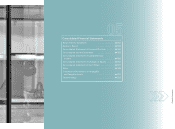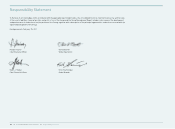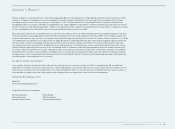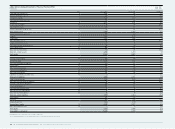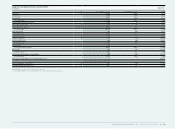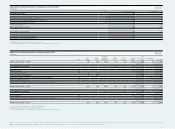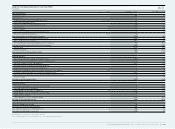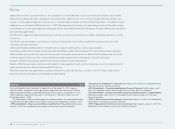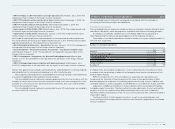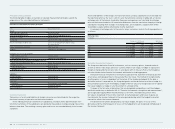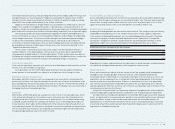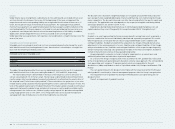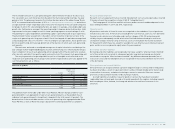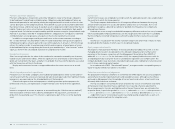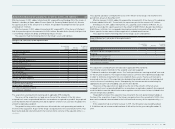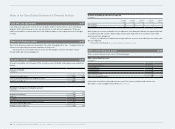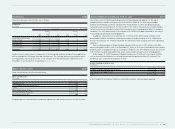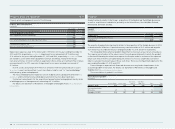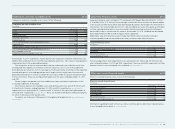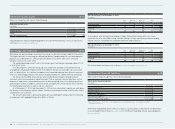Reebok 2010 Annual Report Download - page 194
Download and view the complete annual report
Please find page 194 of the 2010 Reebok annual report below. You can navigate through the pages in the report by either clicking on the pages listed below, or by using the keyword search tool below to find specific information within the annual report.
190 Consolidated Financial Statements Notes
Principles of measurementPrinciples of measurement
The following table includes an overview of selected measurement principles used in the
preparation of the consolidated financial statements.
Overview of selected measurement principles
Item Measurement principle
Assets
Cash and cash equivalents Nominal amount
Short-term financial assets At fair value through profit or loss
Accounts receivable Amortised cost
Inventories Lower of cost or net realisable value
Assets classified as held for sale Lower of carrying amount and fair value
less costs to sell
Property, plant and equipment Amortised cost
Goodwill Impairment-only approach
Intangible assets (except goodwill)
With definite useful life Amortised cost
With indefinite useful life Impairment-only approach
Other financial assets (categories according to IAS 39):
At fair value through profit or loss At fair value through profit or loss
Held to maturity Amortised cost
Loans and receivables Amortised cost
Available-for-sale At fair value in other comprehensive income
Liabilities
Accounts payable Amortised cost
Financial liabilities Amortised cost
Provisions
Pensions Projected unit credit method
Other provisions Settlement amount
Accrued liabilities Amortised cost
Currency translation Currency translation
Transactions of assets and liabilities in foreign currencies are translated into the respective
functional currency at spot rates on the transaction date.
In the individual financial statements of subsidiaries, monetary items denominated in non-
functional currencies of the subsidiaries are generally measured at closing exchange rates at the
balance sheet date. The resulting currency gains and losses are recorded directly in the income
statement.
Assets and liabilities of the Group’s non-euro functional currency subsidiaries are translated into
the reporting currency, the “euro”, which is also the functional currency of adidas AG, at closing
exchange rates at the balance sheet date. Revenues and expenses are translated at exchange
rates on the transaction dates. All cumulative differences from the translation of equity of foreign
subsidiaries resulting from changes in exchange rates, are included in a separate item within
shareholders’ equity without affecting the income statement.
A summary of exchange rates to the euro for major currencies in which the Group operates is
as follows:
Exchange rates
€ 1 equals
Average rates for the year
ending Dec. 31, Spot rates at
Dec. 31,
2010 2009 2010 2009
USD 1.3279 1.3932 1.3362 1.4406
GBP 0.8584 0.8912 0.8608 0.8881
JPY 116.56 130.23 108.65 133.16
CNY 8.9885 9.5148 8.8493 9.8350
RUB 40.303 44.144 40.820 43.154
Derivative financial instruments Derivative financial instruments
The Group uses derivative financial instruments, such as currency options, forward contracts
as well as interest rate swaps and cross-currency interest rate swaps, to hedge its exposure to
foreign exchange and interest rate risks. In accordance with its Treasury Policy, the Group does
not enter into derivative financial instruments with banks for trading purposes.
Derivative financial instruments are initially recognised in the statement of financial position
at fair value, and subsequently also measured at their fair value. The method of recognising the
resulting gains or losses is dependent on the nature of the item being hedged. On the date a
derivative contract is entered into, the Group designates certain derivatives as either a hedge of a
forecasted transaction (cash flow hedge), a hedge of the fair value of a recognised asset or liability
(fair value hedge) or a hedge of a net investment in a foreign entity.
Changes in the fair value of derivatives that are designated and qualify as cash flow hedges,
and that are effective, as defined in IAS 39 “Financial instruments: recognition and measurement”,
are recognised in equity. When the effectiveness is not 100%, the ineffective portion of the
fair value is recognised in the income statement. Accumulated gains and losses in equity are
transferred to the income statement in the same periods during which the hedged forecasted
transaction affects the income statement.
For derivative instruments designated as fair value hedges, the gains or losses on the
derivatives and the offsetting gains or losses on the hedged items are recognised immediately in
the income statement.



